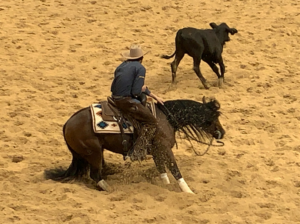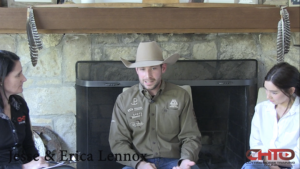
Jesse Lennox and Spots Hottist at the Summer Spectacular in 2021
Developing mastery over the mind game in any sport is probably the hardest thing any competitor has to learn. So this month we bring you a story about a top cutting horse trainer, Jesse Lennox, who has developed a detailed system that has helped his success and may well help guide you to develop your own.
At age 10 he was cleaning stalls, by 14 he was breaking in ponies and a few years later he turned a date into his first job training cutting horses. You could say Jesse Lennox creates his own luck. Where others see a difficult path, Lennox sees opportunity. Despite coming from a non-horse background, Lennox discovered early on that horses were his passion. Little did he know he would go onto work for two billionaires and be at the top of the cutting horse game.
Gerry Hansma, cutting trainer based in Canada and brother to Paul and Winston Hansma, gave Lennox his first job loping and riding two year olds. Lennox credits Hansma with having a major influence on his training career. Hungry to learn and eager to do what it takes, Lennox uprooted his life in Canada and moved to Texas at just 19 years of age to work for Casey Green. Through hard work, good fortune and some of that Lennox charm, the young trainer soon got the opportunity to start two year olds for billionaire Alice Walton, heiress to the Walmart empire. He eventually became her trainer and quickly made a name for himself winning major titles like the NCHA Summer Spectacular Classic Challenge in 2015.
After Walton sold everything and got out of cutting he was employed by his current employer, oil and energy billionaire, Bobby Patton, who owns Rocking P Ranch at Weatherford, TX.
The $2.3 Million earner has learned from many talented trainers such as Lee Francois and Adan and Ascension Banuelos. He studies the sport on all levels. Lennox has spent time pondering all aspects of the sport and coming up with a mental game plan for himself at shows. While it is helpful to learn from others, he said he makes sure that whatever new methods he experiments with, he stays true to himself and his program.
He offered a tip to help cutters get the most out of new information when seeking help from another trainer or someone more experienced than them.
“Make sure you diagnose the problem correctly before you change anything. Work out if it was a horse training mistake, if it was a horse preparation mistake, it is a showmanship mistake and make sure you’re thinking of every aspect of the game. Oftentimes when you’re dealing with animals it can be hard to see what the true problem is. We can chase pretend problems and get up really early in the morning and not progress.”
Lennox remembers Francois telling him early on how to fix a problem and then Lennox would over-correct. Francois told him to think about it like backing a trailer: it’s about small corrections and being just enough. It does no good to go too far one way and then have to go back the other way.
“I started thinking of cutting as a shuffleboard. It’s a feel thing and it’s just enough. Everything is just enough.”
“I think back to Cinca Im Hot’s Futurity finals run,one of the best runs of my life. But definitely an example of just because you can doesn’t mean you should. Or there is such a thing as too much. The penalties were astronomical, it was really cool what was happening but less could have won. But that much couldn’t.”
Jesse said cutting is not about teaching the horse a task and then you’re done.
“Should I have them hooked to a cow or listening to me? The answer is a little of both. It’s a game of a little of both. Should I have them crawling around a lot or should I have them being careful and slow, the answer is a little bit of both…I guess that’s what’s so addicting to the game…It’s not good enough to just stop big, it’s not good enough to just crawl around…”
Lennox compares cutting to golf. He said when you are in the show pen with the best in the business you start to see your opponent’s mental preparation. Trainer Spud Sheehan told Lennox that a horse will do exactly as it is trained to do and that is the problem Lennox added. It’s a different mindset to train horses and then show them.
Lennox said “I’m a horse trainer, up until I’m done working my horse the morning of the show.”
Then he needs to focus on getting the horse shown and getting in the right mind set. Lennox has developed a comprehensive process that he works through, to mentally prepare for showing. Number one: Trust the mental process. He said you will hear people say “trust your training,” they’re trying to get you to quit trying to train and worry about horse-showing before you show.
“I’m going to execute my [showing] steps. Because the steps are what you need to accomplish to have a successful run.”
Step 2: “When I’m walking down to do my dry work, I’m to breathe slowly, calmly remembering that this is just another horse and this is just another run. I’m glad I’m nervous because it means I care but there’s no sense in letting nerves decrease my performance. I just let go of everything and try to tell myself that I’m going to perform with my subconscious mind. Which means I’m just going to let muscle memory do the work for me.”
Then, after Lennox tells his help his cow selection, “Right before I walk down there I tell myself that this is my dream and it’s for me. Nobody else. I’m a people pleaser so earlier in my career I would have people’s wishes for this horse, their dreams, on my back and then I’m feeling like I’m making them happy or disappointing them. No one can perform successfully with other people’s desires on their plate.”
Lennox said cow selection is crucial, no matter how talented the horse. He said it’s where the less favored horses can pull off a win. He said trainers who can adjust their plan while in the herd have an advantage.
“I love watching cows. It’s one of the best parts of our game. And I’m going to cut a cow I like. [In my cut] I’m going to put that cow in a good position to accept the cut. If it does not accept the cut I’m going to let it go. This is a free flowy deal, there are no hard rules. The only rule [for me] is that I walk down there and position a cow that I like that I know feels good and I give it the chance to accept the cut, then I put my hand down without bridle contact if at all possible.”
He also reminds himself to be patient on the quits and to walk slowly through cattle, moving in ways cows like.
Then for the second cow, he sits on the edge of the herd, listens to help and cuts another cow.
In regards to the clock, Lennox refers to Austin Shepard’s showmanship DVD. Lennox said he remembers Shepard saying he wants to put his hand down on his second cow with a minute left.
Lennox said the third cut can really unwind a run. He adds that people don’t realize how much slowing down can give you control. If you’re trying to chip a cow off and the cows are flustered, slowing down will be the best route.
“I try to tell myself [not to] put myself in a position where I have to get lucky. Just put myself in a position where I will succeed if I do a good job. That has really helped when it comes down to trying to win a cutting…Just try to up your odds.”
Jesse said to be successful at any sport all you have to do is have one good play after another good play.
“If things don’t work out the way I envision they should, I try to think about what the next relaxed, smart decision I can make is.”
If in doubt Lennox will think, what would Lloyd Cox do? As a student of the sport, Lennox has identified a few aspects that make the good trainers like Adan, Lloyd and Austin, so good. They have the horse part down, their mental game is very strong and they find a way to make a run work.
“The game has changed in the 12 years I have worked in Texas. Thanks to [CHTO] everyone has the horse training part down. So now it’s such a showmanship game.”
“They maintain a very competitive headspace for themselves… You’ll notice a lot of them have very relaxed, level personalities. I think that’s very important, we play a sport where a cow can just mess up everything you had planned. It’s a very hard game, maybe harder than most sports because I don’t know of any other sport that deals with so many other animal’s minds that need to align with your mind for it to work.”
Lennox added that in the last five years we have seen some of the trainers really control the circumstances of a run that should be uncontrollable. Twelve years ago, Lennox said a bad run was blamed on a bad cow, not all horses can make the finals anyway. And then Adan started getting all his horses to the finals.
“That’s been the most fun part, it’s helped me re-fall in love with the sport. Because it’s proof that it can be done.”
